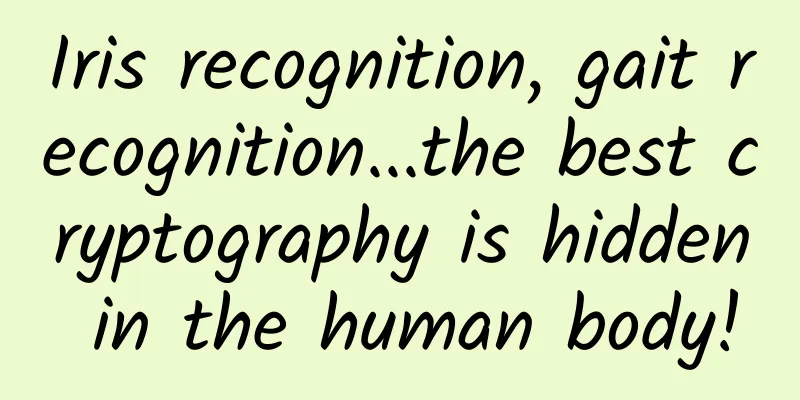Iris recognition, gait recognition...the best cryptography is hidden in the human body!

|
When it comes to passwords and cryptography, people will easily think of a screen full of numbers and letters, or even scenes of telegrams and code books in spy dramas. It feels like an extremely mysterious field that is very far away from us. But if I tell you that your life, especially in today's smart life, is frequently using password technology, do you think it's incredible? Let's take the most common "unlocking" as an example to see the password technology hidden in smart door locks. Open Sesame Smart door locks provide many convenient ways for us to choose, such as password unlocking, IC (or ID) card unlocking, fingerprint unlocking, face unlocking, etc. As the first line of defense, locks should pay more attention to safety while considering the convenience of unlocking. After all, no one expects that when it is convenient for themselves to unlock, it also provides "convenience" for people with bad intentions. 1) Password unlocking Password door locks are very common. You can open the door by entering your pre-set password. Some people here may ask: If there are outsiders around, wouldn’t it be like having the key if someone remembers the password? Don’t be afraid. Smart door locks have a virtual password function, which means you can add any number before and after the correct password. As long as the correct password is in the string of numbers you enter continuously, the door can be unlocked. In this way, others will not know which part of the array is your real password, and it is even more impossible for them to remember the password of your door lock! Another way is to use a dynamic password to ensure security. When you need to open the door, a password is randomly generated through a mobile phone APP. This password is only valid for a period of time. If you enter it again after the timeout, you will not be able to unlock the door. Does it remind you of the protagonist in a spy movie who receives secret information and burns it after reading it? The only difference is that the smart door lock will "burn" it for you. This instant change greatly reduces the possibility of password theft. 2) IC (or ID) card unlocking/NFC unlocking IC (or ID) card unlocking is widely used and also quite common. It is not only suitable for home door locks, but also for places with larger areas and more complex personnel, such as community access control, bus cards, etc. However, IC (or ID) cards are easy to copy. As long as the information on the card is copied to another card, the copied card can open the smart door lock, which is as convenient and dangerous as making a key. In order to prevent copying, manufacturers will encrypt the card, just like you have a pearl, put it in a box to collect, for safety reasons, you put another layer of box from the outside, or even put two or three layers of boxes again. The more layers of boxes, the higher the encryption level, of course, it will be more wasteful. We often determine the encryption level of the card according to needs. For example, the encryption level of the bus card is higher than the community access control. The home smart door lock belongs to the first and most important layer of protection at the home level, and the encryption level requirement is higher than the community access control encryption level. In the actual testing of the professional third-party testing agency, China Institute of Home Furnishing (Beijing) Testing and Certification Co., Ltd., the encryption level of IC (or ID) cards varies. The IC cards of some brands of smart door locks are easily cracked and copied, which is very unsafe. NFC unlocking is done by using an NFC-enabled bracelet or other portable smart device to touch the NFC sensing area of the door lock to unlock it, similar to using an IC (or ID) card. Therefore, when the NFC encryption method is insufficient, the security of the NFC function is also insufficient. 3) Remote unlocking via App APP remote unlocking is to start the unlocking function through the APP of a mobile phone or other terminal. The unlocking information is sent to the door lock through the cloud server, and the door lock unlocks after receiving the unlocking information. During this whole process, the information is transmitted in a way that you cannot see or touch. Do you think that this unlocking method without a physical object is safe? You are wrong. In front of professional software and tools, what you can't see may be clear to others. If the transmitted unlocking command is not encrypted at all, or the encryption level is low, the unlocking command information can be obtained through actions such as packet capture and replay, and then your door lock can be easily opened. 4) Fingerprint unlocking Maybe you haven't discovered that the seemingly inconspicuous fingerprints on your tiny fingers are also unique in the world. Almost everyone's fingerprints are different. Fingerprint unlocking uses this to recognize different people by identifying different fingerprints. First, you need to enter your fingerprint, so that the door lock can remember your fingerprint. Every time you unlock the door, you can use the entered finger. The door lock can immediately recognize you as its owner, giving you the "golden finger" to unlock the door instantly. The fingerprint recognition modules commonly used in door locks now mainly include photoelectric fingerprint modules and capacitive fingerprint modules. Photoelectric fingerprint recognition mainly uses the principle of light refraction and reflection. When you put your finger on it, a small light source inside the lock body will shoot light from the bottom of the prism to your finger, and then refract it through the surface glass plate to the fingerprint module composed of optical sensors. This technology is currently in the market for a long time and is relatively mature, but it is still inevitable that there are shortcomings that cannot be overcome. For example, when the finger is relatively dry, it is difficult for the grain surface and the glass surface to fit completely and thoroughly, and at this time it is difficult for the fingerprint module to recognize accurately. Therefore, if your hands are too dry, your door lock will easily "reject" you! Capacitive fingerprint recognition mainly uses the characteristics of capacitance to identify fingerprints. When your finger is placed on the sensor, your finger becomes another set of plates. The sensor's capacitor plates correspond to your fingers one by one, forming countless capacitors. You can imagine it as countless pools that can store electricity. The size of the pool is related to the distance between the surface of the finger and the built-in plates of the lock. Countless electricity pools of different sizes are formed between your uneven fingerprints and the door lock. The door lock can identify where is "convex" and where is "concave" by charging, discharging, and timing these pools. In this way, your fingerprint map is "drawn" in the door lock's brain. Of course, no one is perfect, and this method of fingerprint recognition also has its shortcomings. Since water can conduct electricity, if a wet finger is placed on the door lock, it will naively identify the "texture" of the water as the texture of a human finger, and it is naturally difficult to successfully identify it, so its natural enemy is wet fingers. 5) Finger vein recognition Vein recognition technology uses the structure of veins to identify people. Like fingerprints, the intricate vein pattern structure inside the finger is also a unique feature point that distinguishes people from each other. It contains a lot of feature information and can be fully utilized in the finger vein recognition process. Moreover, these feature points will not be unrecognizable due to injury or deformation of the skin on the finger surface. In terms of security, finger veins are slightly better. Because fingerprints and faces are exposed to the outside, they are easy to be stolen by illegal personnel, but finger veins exist in the human body and are difficult to be stolen by others. This method of unlocking is safer. 6) Face recognition unlocking "This is an era of face-watching", this sentence also applies to smart door locks, but it does not care about your beauty or ugliness, but cares about the features of your face. It records and identifies these features and then decides whether to unlock the door. This is facial recognition. Now, face recognition technology faces such a difficult problem: on the one hand, in order to improve the user experience and reduce the poor experience of not being able to open the door or having to open it multiple times, the number of feature points to be recognized is reduced. To give a simple and crude example, originally you needed to have small eyes and a high nose bridge to open the door, but now you can open the door as long as you have a high nose bridge. In this way, you won’t have the problem of not being able to open the door lock one day because you made your eyes bigger with makeup. But if there is only this one requirement, it means that any person with a high nose bridge can be recognized as you by the door lock and can easily open the door. Isn’t it scary to think about it? On the other hand, in order to improve the security level, the dimension of feature point recognition is increased, that is, your face must be exactly the same as the face you entered at the beginning each time you unlock the door in order to unlock it. However, due to various internal and external factors such as facial expressions, makeup, wearing glasses, hats, position, angle, light, etc., it is inevitable that your face will change slightly each time you face the door lock, so the success rate of face recognition will drop sharply, which is the so-called increase in the false rejection rate, causing the real owner to be frequently rejected by the door lock. In addition to the dilemma above, face recognition technology also has the difference between two-dimensional (such as photos) and three-dimensional. In two-dimensional recognition, there is a situation where photos can also be used to open smart door locks. Therefore, in order to prevent the use of photos to impersonate real people, a liveness detection algorithm is needed, such as using binocular cameras to form a three-dimensional image, or using structured light sensors to recognize facial information, or more deeply using dynamic authentication methods such as letting you blink, open your mouth, shake your head, etc., which can further improve security. Be on guard against others Through the introduction above, I believe you can also see that no password is an iron wall. For the sake of safety, here are some tips for protection: (1) When using a numeric password, try not to use numbers like 666666 or sequential numbers. Remember, a password that is easy for you to remember is also easy for others to remember. If you are still worried and want to increase the security of your password, you can change your password regularly. (2) If you prefer biometric passwords (such as fingerprints, faces, etc.), when you decide not to use them anymore, remember to delete the biometric features you entered previously. In addition, try not to use facial information as the only credential, because facial information is the most public and easiest to collect. You can use multimodal recognition, such as a combination of face and fingerprint, which can greatly improve security. (3) For door locks that can be unlocked remotely via APP, you should carefully choose to use this function when setting it up. When purchasing door lock products, choose products with safety certification, as such products are more secure. The top student in cryptography Although any password can be cracked, they can be classified into different levels according to the difficulty of cracking. Human exploration of cryptographic technology has been progressing, and attempts have been made to combine passwords with human organs to improve security and convenience. This type of password can be regarded as an "excellent student" in cryptography in terms of effectiveness and security. 1) Iris recognition The eyes are the windows to the soul, and cryptography has given it another use, which is iris recognition. Most of you may not know the exact location of the iris. It is the circular part between the black pupil and the white sclera, which contains many interlaced spots, filaments, crowns, stripes, crypts and other detailed features. Unlike the human face, which is easily affected by various internal and external factors, the iris will not change dramatically throughout the life course after it is formed during the fetal development stage. These points determine: a unique iris corresponds to a unique identity. Iris is also a kind of biometric feature. It is precisely because of its uniqueness, stability and liveness detection that it is highly expected by the cryptography community. Some experts believe that it will be the main way of identity authentication in the future. However, the collection of iris has high requirements for equipment. At present, iris recognition technology is used in important scenes that require high-intensity security, such as bank vaults, computer rooms, accounting archives centers, etc., where access is strictly restricted. After all, good steel should be used on the blade. 2) Gait recognition Gait recognition is an emerging biometric recognition technology that uses the way a person walks to identify someone. That is, the distance you take each step, which foot you use more force on, whether you walk with your back bent or with your chest and head held high, etc. These behavioral habits that you may not even notice are all the basis for identification. Although gait recognition is still a concept car at a car show and has not been commercialized, as deep learning technology matures, it is gradually being applied to gait recognition. I believe that in the near future, there will be products that can identify identity through the "style" of walking. Whether you walk with a spring breeze or a tread on thin ice, you are you, and only you. 3) Voiceprint recognition Voiceprint recognition technology is a technology that identifies the speaker's identity through voice. The vocal organs used by people when speaking - tongue, teeth, larynx, lungs, nasal cavity - vary greatly in size and shape from person to person, so even if two people say the same sentence, the voiceprints they produce will be different and sound very different. There are two types of voiceprint recognition technology: speaker identification and speaker confirmation. Different tasks and applications will use different voiceprint recognition technologies. For example, identification technology may be needed to narrow the scope of criminal investigation, while confirmation technology is needed for bank transactions. The People's Bank of China officially released the financial industry standard "Technical Specifications for Mobile Financial Security Applications Based on Voiceprint Recognition", which means that voiceprint recognition technology has been recognized by financial regulatory authorities and has solved the standard problem for voiceprint recognition technology to enter the mobile financial field. Therefore, "recognizing people by their voices" is no longer a unique skill of humans. Using data and algorithms to give machines a pair of sensitive ears can simultaneously provide an umbrella for our personal safety and property safety. As the most complex and profound system, the natural biological characteristics of the human body are the best cryptography. As long as we continue to study in depth and improve technology, in intelligent life, we can use ourselves to serve ourselves and use magic to defeat magic. Author: Jiao Limin, Senior Engineer, China Household Electrical Appliances Research Institute This article was published by Tencent's "Everyone Loves Science" team Please indicate that the source of the reprint is from Science Popularization China |
Recommend
Sailing east six times? This is Jianzhen's voyage eastward
Sailing east six times? This is Jianzhen's vo...
Community operation: How to increase the number of community topic releases?
Community operation is a very long process that r...
Too detailed, you will never be afraid of not finding your way in Kunming's high-end tea drinking studio in 2022! This WeChat is worth collecting (latest version)
Recommended projects of the club (only the introd...
Fishing skills, professional fishing video tutorials, fishing experts teach you how to master fishing skills, fishing video skills tutorials, practical fishing skills
Fishing skills, professional fishing video tutori...
What is the process of Baidu search engine advertising?
What is the process of Baidu search engine advert...
With its performance plummeting, will Nikon become the next Kodak?
In the 1970s, American imaging giant Kodak invente...
Chen Hesheng | China Spallation Neutron Source
About half of the Nobel Prizes in Physics and Che...
The title of the video with one million views on Bilibili deserves to be so popular!
Hello friends, I was looking for topics on Bilibi...
Is the new iPhone SE your next iPhone?
When everyone thought that the 2018 iPhone 8 seri...
Zhou Yiting's "Ding Ding Desensitization Intensive Training Course" choose the right method to delay the time by 3 times
Training course content: Instructor: Zhou Yiting,...
The "Second Uncle" in the scientific community: He turned a disaster into a blessing twice and eventually became a great scientist
A video describing the past half of the life of t...
Be careful when eating spring vegetables! Save this guide to tasting fresh vegetables →
The fragrance of wild vegetables in spring Chines...
Case analysis: The entire process of Xiaohongshu product operation and promotion!
1. Analyze the product The first step in promotio...
His and Her Feast, Traveling Through 3,400 Years
Produced by: Science Popularization China Author:...
After the Permian mass extinction, the Earth was reshuffled, and many "monsters" appeared in the sea...
The distinctive feature of the placodontosaurs ar...









